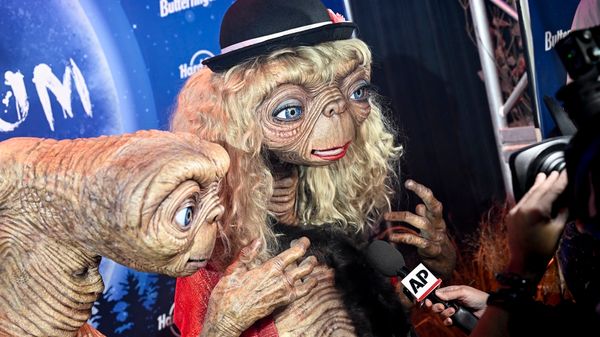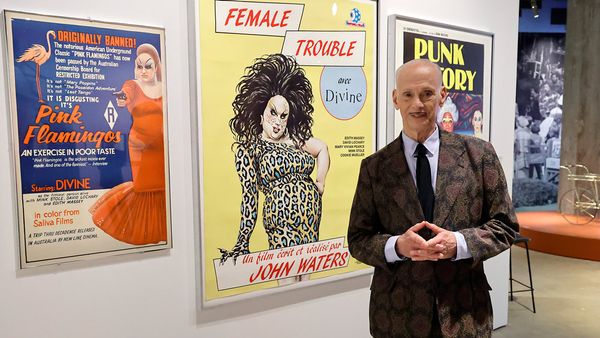
May 7, 2017
Born to Kvetch
Sura Wood READ TIME: 4 MIN.
Roz Chast is still kvetching after all these years with a wacky, angst-ridden humor that's a tonic for troubled times. The veteran New Yorker magazine cartoonist - readers of that publication will be familiar with her many covers and multi-panel stories inside the book - is now the subject of "Roz Chast: Cartoon Memoirs," a large, thoroughly entertaining exhibition that opened last week at the Contemporary Jewish Museum.
The exhibition includes a range of original cartoons from The New Yorker, as well as illustrations from Chast's charmingly acerbic books for children and adults, and projects with collaborators such as musician Stephin Merritt and others. The works that represent the unadulterated Chast, where she's both writer and illustrator, may be strongest, but there are no misses here. The show is a blast.
Unafraid to summon her inner crabby-appleton, she has an uncanny knack for being right on target with pithy commentary on relatable situations, giving voice to thoughts you may have had but were too polite to express. In fact, she's so witty and clever it's easy to overlook the high caliber of her deceptively simple artwork. Visitors are sure to have cartoons they'll want to share with friends, such as a single panel on highway driving in which lanes are divided thusly: Control Freaks, Clueless Numbskulls, Passive Aggressives; and her alternate versions of Edvard Munch's "The Scream": The Yawn and The Pout.
In her cautionary tale "Bedtime Stories for Adolescents," she singles out both the "girl who wanted to be a poet" who "dies penniless and alone" with the tombstone inscription "RIP whoever you are"; and the wayward son with a bright future who ends up "working in a traffic cone factory." Budget plenty of time; you'll need it to take in the written text of her cartoons, and believe me, you'll want to consume all you can. Never has so much laughter been possible in the solemn halls of a museum.
Combining early success, longevity and luck, Chast is a prime example of someone who fell into her field and can't imagine doing - or being capable of doing - anything else. She sold her first cartoon to Christopher Street magazine, a gay publication that paid her a whopping $10. The Village Voice followed, and in 1978, barely two years out of Rhode Island School of Design, came the big kahuna: The New Yorker accepted her first submission and put her under contract. "I was flabbergasted," she recalls. 1,200 cartoons and covers later, the rest, as they say, is history.
A native New Yorker, Chast, who works from her home in Ridgefield, Connecticut, where she lives with her family and a pair of pet parrots, misses the city. "I think about it every day," she tells me. "But recently, I began keeping a studio apartment on the West Side. It's my pomme de terre." Slight, petite and dressed in the cartoonist's uniform of black jeans and sneakers, she's impish, unpretentious and as down-to-earth as your best gal pal, only funnier. When asked her thoughts on the "certifiable genius" tag assigned to her by New Yorker editor David Remnick, she screwed up her face and uttered, "Argh!" with feeling, twice.
The daughter of Brooklyn educators - a gentle, excessively anxious Dad, and a volatile, willful mother, who often clashed - Chast grew up in a hotbed of neurosis and turned a litany of pessimism and complaint into material that has rocketed her to the top of her career. The "Merck Manual of Diagnosis and Therapy," an ever-present fixture in Chast's childhood displayed here, was a terrifying encyclopedia of doom that predicted the worst possible outcomes and lethal consequences for seemingly innocuous symptoms. As Chast comments in a category on illness in one my favorite of her books "What I Hate: from A to Z," a sore throat was never just a sore throat, it was a prelude to leprosy.
Also included in this catalogue of dread and danger, laid out in alphabetical order with cartoons and supplemental text: Alien abduction, doctors, spontaneous human combustion, and premature burial (at least with a mausoleum, she points out, "you can bang on the door and get out: Crisis averted.") She describes elevators as "a perfect storm of claustrophobia, agoraphobia, and acrophobia," where you get stuck by yourself, or worse yet in a crowd, or with a psycho, and then there's the obvious: Plummeting to your death because someone cut the cables. After reading this, you may want to take the stairs. When it comes to X-rays, she wryly observes: "If you look that deeply inside someone, you're going to find trouble." Case closed.
The exhibition also features most of the original artwork from "Can't We Talk About Something More Pleasant?," her best-selling graphic memoir about her elderly parents' decline and death. Touching and ruefully funny, it will evoke moments of recognition and even chuckles from those who've gone through the experience, which can be comically absurd, excruciating, and financially ruinous for parents and their adult children. Those moments of solidarity, a pleasure well-known to Chast's fans, come as much from her authenticity as from her merciless wit. Underneath a drawing of her bedridden mother toward the end of the book, she penned this lament: "I wish that, at the end of life, when things are truly 'done,' there was something to look forward to. Perhaps opium or heroin [or] all-you-can-eat ice cream parlors for the extremely aged." Me too.
Through Sept. 3. thecjm.org







